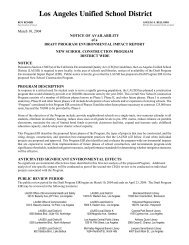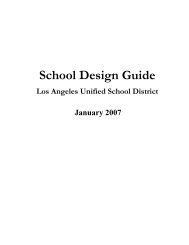Site-Specific Health and Safety Plan (HASP) - Laschools.org
Site-Specific Health and Safety Plan (HASP) - Laschools.org
Site-Specific Health and Safety Plan (HASP) - Laschools.org
Create successful ePaper yourself
Turn your PDF publications into a flip-book with our unique Google optimized e-Paper software.
A column test procedure for determining sorbed hexavalent chromium is included as<br />
Appendix A.<br />
6.2 DETECTION AND QUANTITATION LIMITS<br />
This section describes the terms, definitions, <strong>and</strong> formulas that will be used for detection<br />
<strong>and</strong> quantitation limits.<br />
6.2.1 Method Detection Limit<br />
The method detection limit (MDL) is the lowest concentration at which a specific analyte<br />
in a matrix can be measured <strong>and</strong> reported with 99-percent confidence that the analyte<br />
concentration is greater than zero. MDLs are experimentally determined <strong>and</strong> verified for<br />
each target analyte of the methods in the sampling program. Instrument-specific MDLs<br />
are analyzed in accordance with 40 CFR Part 136. The lab will spike at a level equal to<br />
the lowest calibration st<strong>and</strong>ard. In order to maintain reporting consistency, if multiple<br />
instruments are used for the same method, the lab will report down to the highest MDL<br />
between all instruments so that all MDLs for a given analyte are at or below the reported<br />
MDL. MDLs are verified quarterly with a spike at ½ of the low calibration st<strong>and</strong>ard.<br />
Since MDLs are verified quarterly <strong>and</strong> in accordance with California Department of<br />
<strong>Health</strong> Services Environmental Laboratory Accreditation Program (ELAP) policy on<br />
Method Detection Limits, annual MDL studies are not performed unless a problem is<br />
identified during the quarterly verification process. MDLs are based on the results of<br />
seven matrix spikes at 2 times the estimated PQL, <strong>and</strong> are statistically calculated in<br />
accordance with the Title 40, Code of Federal Regulations Part 136 (40 CFR 136),<br />
Appendix B. The st<strong>and</strong>ard deviation of the seven replicates is determined <strong>and</strong> multiplied<br />
by 3.14 (i.e., the 99-percent confidence interval from the one-sided student t-test). Where<br />
practicable, MDLs must be lower than the risk-based criteria determined for the project.<br />
The MDLs to be used are intended to allow that both nondetected <strong>and</strong> detected target<br />
compound results will be usable to the fullest extent possible for the project. An MDL<br />
check sample, an interference-free MS with all method target compounds, must be<br />
analyzed following the MDL study to determine if reasonable MDL concentrations have<br />
been achieved. The MDL check sample should be at a concentration of approximately<br />
two times the MDL. If any target compound is not recovered, the MDL study must be<br />
repeated. In this case, the repeated MDL study should be performed with a higher<br />
concentration, based on the analyst's judgment, of the target compounds which failed in<br />
the MDL check sample. The MDLs shall be verified quarterly by running a st<strong>and</strong>ard at<br />
½ the concentration of the lowest st<strong>and</strong>ard of the initial calibration. If the verification<br />
analysis shows lack of adherence to the determined MDLs, then the MDL study shall be<br />
repeated.<br />
6.2.2 Sample Quantitation Limit<br />
Sample quantitation limits (SQLs) are defined as the MDL multiplied by the dilution<br />
factor (DF) required to analyze the sample, <strong>and</strong> corrected for moisture or sample size.<br />
These adjustments may be due to matrix effects or to the high concentrations of some<br />
analytes. For example, if an analyte is present at a concentration that is greater than the<br />
linear range of the analytical method, the sample must be diluted for accurate<br />
quantitation. The DF raises the reporting limit, which then becomes the SQL. Because<br />
6-2<br />
K:\Depts\Dept48\LAUSD\MSA WORK\QAPP\Draft Final QAPP to DTSC\QAPP for OU 1 RAP.DOC<br />
303







